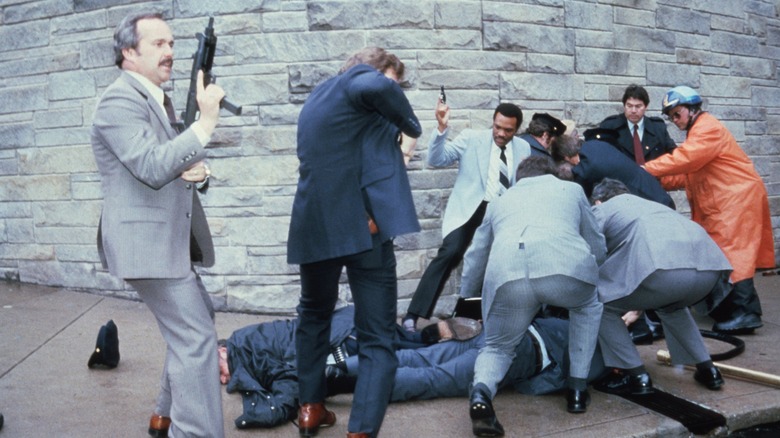The Odd Connection Between Reagan's Assassination Attempt And Clapton Drummer Jim Gordon
For those looking to book the next one-man acoustic indie artist for a music festival, look no further than the writer of "We Have Got That Chemistry" and "You Let Your Whiskey Do Your Talking," John Hinckley. That's right — John Hinckley, whose meteoric rise to fame following his attempted assassination of President Ronald Reagan in 1981 led to ... Wait a second, John Hinckley has a Spotify account? And a Twitter account with over 50,000 followers? And sells cat paintings on eBay? What kind of timeline did we end up in, anyway?
Apparently, we ended up in the timeline where John Hinckley gets to play the role of a Gen Z content creator after being released from psychiatric care. As NPR says, the former presidential assassin was dubbed a "low risk for future violence" after over 41 years of court-mandated, out-of-prison supervision. But back when Hinckley squeezed through the crowd and fired six pistol rounds at President Raegan near the Washington Hill Hotel in Washington D.C., he was very much a high risk for future violence. In 1982, Hinckley stood trial and was found "not guilty by reason of insanity," an often-dramatized plea raised in only 1% of all criminal proceedings — and only 0.25% of those attempts succeed, as Psychology Today cites. Hinckley never went to prison, and subsequent public uproar led to 1984's Insanity Defense Reform, which made it harder for future defendants to use the insanity plea. One such defendant, drummer Jim Gordon, was subsequently sentenced to 16 years in prison.
Matricide and schizophrenia
On March 15, 2023, it was announced that drummer Jim Gordon died. Gordon was a studio session drummer for Eric Clapton, among others, and even shares a songwriting credit for Clapton's legendary 1970 track "Layla." Gordon played drums for the likes of Cher, John Lennon, Alice Cooper, Joan Baez, and Neil Diamond, and was the in-demand drummer for many an artist until he started using alcohol and drugs in the mid-70s. In 1985 he told Rolling Stone, "I was drinking every night, but I wasn't getting up in the morning for a drink; I would put a needle in my arm. When I stopped taking the heroin, I began to drink all day." That's when Gordon started hearing voices.
Gordon's mother, whom he once called his "only friend," urged him to get help. By 1983, he felt compelled to kill her. "I wanted to stay away from her. I had no choice," The Guardian quotes him as saying two years later, continuing, "It was so matter-of-fact, like I was being guided like a zombie. She wanted me to kill her, and good riddance to her." And so, as Variety says, Gordon beat and stabbed his 72-year-old mother to death.
Gordon had already been diagnosed with schizophrenia by then. But because of the timing of his trial and the newly enacted, John Hinckley-inspired Insanity Defense Reform, the insanity plea didn't work for him. He was given 16 years in prison on second-degree (unplanned) murder.
Reforms to the law code
John Hinckley and Jim Gordon were only the latest additions to a long evolution in U.S. law code regarding the relationship between sanity and crime. In 1581, the English court system differentiated between a momentary act of "lunacy" and someone who, in a general sense, lacks an understanding of the consequences of one's actions. And since early U.S. law was copy-pasted from English common law, the same rule took root in the U.S. In 1843, the insanity plea took firmer shape following the trial of Scotsman Daniel M'Naughten, who personally blamed the U.K. Prime Minister Robert Peel for his financial and personal woes and plotted to kill him. This gave rise to the M'Naughten test, which asked if the defendant was so frenzied at the time of a crime as to be unable to distinguish between right and wrong.
By the 1950s, the M'Naughten test gave way to the more psychiatrically-leaning Durham rule, which stated that a person wasn't accountable for a crime if it was the "product of mental disease," per PBS Frontline. In 1962, the American Law Institute (ALI) modified this definition to say that a defendant must demonstrate a "substantial capacity" to understand right and wrong. After the 1981 attempted assassination of President Reagan, many states moved away from the ALI standard and back toward M'Naughten. This eventually paved the way for the "guilty but mentally ill" verdict of 1984's Insanity Defense Reform, which allows for mental health treatment in an institution despite an acknowledgment of guilt for the crime.
If you or anyone you know needs help with addiction issues, help is available. Visit the Substance Abuse and Mental Health Services Administration website or contact SAMHSA's National Helpline at 1-800-662-HELP (4357).
If you or someone you know needs help with mental health, please contact the Crisis Text Line by texting HOME to 741741, call the National Alliance on Mental Illness helpline at 1-800-950-NAMI (6264), or visit the National Institute of Mental Health website.


